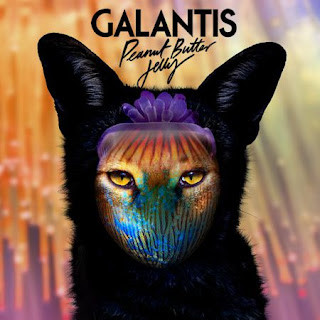The thumping bassline and infectious melody of Galantis’s “Peanut Butter Jelly” can instantly energize a workout class or become the soundtrack to a carefree afternoon. I first encountered this track in a BodyPump class, and its immediate impact was undeniable. Amidst the lunges and squats, the song’s quirky lyrics and driving rhythm had me hooked. Lines like “Sleepless nights at the château” and “Visualize it” mingled with the repetitive, catchy chorus, creating a sonic experience that was both intriguing and, admittedly, a little bizarre. “Kush kush?” or was it “cutch cutch?” – the lyrics sparked curiosity and a definite urge to learn more about this earworm. Returning home, a quick search of the BodyPump tracklist revealed the song: “Peanut Butter Jelly” by the Swedish electronic duo, Galantis.
Image: Peanut Butter Jelly song cover art by Galantis. The vibrant and playful single artwork perfectly captures the song’s energetic and quirky nature.
However, my initial enjoyment took a turn when I stumbled upon a comment on a blog post discussing the BodyPump tracklist. A BodyPump instructor expressed strong disapproval of “Peanut Butter Jelly,” labeling the lunge track as “misogynistic and obscene.” The comment questioned the suggestive lyrics, particularly “Spread it like I owe you some money,” interpreting them as demeaning and objectifying. This starkly contrasting viewpoint gave me pause. Had I overlooked a problematic undertone in my initial enthusiasm for this seemingly upbeat dance track? It wouldn’t be the first time I’d found myself drawn to something later revealed to be viewed critically by others.
This experience resonated with past instances where my appreciation for certain art forms clashed with prevailing critical opinions. Take Federico Fellini’s films, for example. I admire their exploration of desire and sexuality, yet these very themes often lead to accusations of sexism. As I’ve previously discussed, the portrayal of male desire in cinema is frequently scrutinized through a different lens than female desire, highlighting societal double standards. When a woman expresses appreciation for films exploring male promiscuity, it can raise eyebrows and trigger accusations of condoning sexism. However, often, these narratives are reflections of societal norms and power dynamics, not necessarily endorsements of them. The issue, arguably, lies not solely within the art itself, but within the broader societal context that shapes its interpretation.
Similarly, the controversy surrounding Robin Thicke’s “Blurred Lines” comes to mind. Despite the widespread criticism, I found the song undeniably catchy and even appreciated its playful, albeit provocative, lyrics. The backlash focused on lines like “You know you want it,” the music video’s depiction of women, and the concept of “blurred lines” itself, interpreted by many as promoting non-consensual behavior. While I understood these critiques, my reaction was less condemnation and more a sense of “that’s unfortunate, because it’s otherwise an enjoyable song.” It seemed as though the societal baggage surrounding sexualization was overshadowing any potential for simple, perhaps even ironic, enjoyment. In an ideal world, diverse representations of sexuality in media, including those that are overtly sexual, could exist without automatically being labeled as problematic or exploitative.
The polarized reactions to “Blurred Lines” highlighted a lack of nuanced discussion. Opinions seemed to fall into extremes: either complete condemnation or staunch defense, with little room for ambivalence or layered interpretation. This black-and-white thinking echoed in the reaction to “Peanut Butter Jelly.” The instructor’s comment represented one extreme of viewing the song as inherently offensive. But what about other interpretations?
Seeking deeper understanding, I turned to online forums like Genius to explore different perspectives on “Peanut Butter Jelly.” The lyrical analysis revealed a fascinating ambiguity. The meaning of “kush kush” remained debated – was it a reference to marijuana or the Welsh term “cwtch cwtch” for a hug? The phrase “ace high” sparked questions about gambling metaphors versus broader symbolism. Even “visualize it” seemed open to interpretation. The lack of clear consensus suggested a deliberate lyrical vagueness, perhaps contributing to the song’s broad appeal and adaptability to different contexts.
An interview with Galantis in Rolling Stone promised to shed light on the song’s intended meaning. However, surprisingly, the interview focused solely on the song’s retro disco influences and the production process, completely sidestepping any discussion of lyrical interpretation or intended message. This absence of explicit explanation felt significant, perhaps indicative of a modern trend where musical meaning is increasingly fluid and audience-driven, rather than dictated by the artist.
Finally, the “Peanut Butter Jelly” music video offered another layer of interpretation. Set in a grocery store, the video initially depicts mundane scenes of everyday shopping. However, as the song progresses, the atmosphere transforms. Ordinary shoppers, including a roller-skating woman who stands out, become entranced by the music. They shed their clothes, embrace spontaneous dance, and engage in playful interactions. The video embraces diversity in body type, age, and race, showcasing a joyful and inclusive atmosphere of liberation. Yet, questions linger. Is it a celebration of sexual freedom for all, or does it subtly prioritize or objectify certain individuals, like the aforementioned roller-skating woman? The video, much like the lyrics, resists a singular, definitive interpretation.
The ambiguity surrounding “Peanut Butter Jelly” ultimately contributes to its enduring appeal. It’s a song that can be enjoyed purely for its infectious beat and energy, perfect for workouts or carefree moments. But it also invites deeper reflection on themes of sexuality, societal expectations, and the subjective nature of meaning in music. In my BodyPump class the following week, a minor music glitch occurred right before the lunge track. As our instructor, known for his inclusive and vibrant personality, rectified the issue and “Peanut Butter Jelly” began to play, he paused, smiled, and simply said, “I love this song.” And in that moment, surrounded by the song’s infectious energy and its playful ambiguity, I wholeheartedly agreed. The “Peanut Butter And Jelly Song” is more than just a catchy tune; it’s a cultural touchstone that sparks conversation and embodies the complexities of modern musical interpretation.



